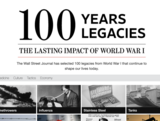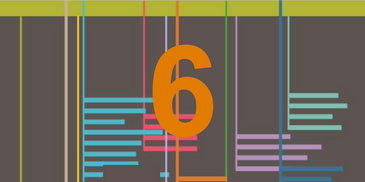
Wall Street Journal interactive that allows students to research and explore 100 ways in which WW1 continues to leave a lasting impact.
- Subject:
- Social Science
- Material Type:
- Interactive
- Provider:
- The Wall Street Journal
- Date Added:
- 11/09/2023

This collection contains highly recommended sixth-grade Social Studies lessons, activities, and other resources from the eMedia library.

Wall Street Journal interactive that allows students to research and explore 100 ways in which WW1 continues to leave a lasting impact.

This inquiry focuses on Mesopotamia and represents just a slice of what students should learn about the development of agriculture and the establishment of human civilization, so additional inquiries may be needed to fully represent the key idea.

This is a large pdf unit designed to have students explore the ever changing and comples roles women played during WW1. Cross curricular--supports literacy standards.

Students match posters, photos, and documents with the ways in which Americans were asked to contribute to the war effort during WW1.

Students analyze a letter written by Jackie Robinson to the White House in 1972. Students are guided to understand that racial equality still had not been achieved during this time. Students analyze tone, audience and context and draw conclusions. Background about Jackie Robinson's role in the Civil Rights movement should be provided to students.

Students analyze a photograph of child laborers and make inferences about the impact of the photograph on the photographer based on the message he was trying to convey. Background information about child workers during the Progressive Era included.

By completing this inquiry, students begin to understand issues revolving around the factors that help to form a people’s identity, as well as the fluidity of defining a group within any predetermined criteria.

This article describes the the ways that ancient rome continue to impact the world today. This resources is great because it can be adusted to meet your students reading level including 6th grade

This is a great resource on what athanian democracy was like. I would probably use this as a place for primary sources. Using directly as written would be a little above 6th Grade.

I use this resources as a basic introduction to the concepts of trade a bartering. It does a fantastic job of giving a basic history from trading individual items to shells and coins and paper money until today when kids still might trade or barter.

Students analyze two letters written by FDR in order to determine the significance that baseball played during WW1 and WW2 in uplifting morale.

This course from the OER Project provides complete lessons, videos, and other resources on the rise of agriculture and early societies, expansion and interconnection among civilizations, economic changes, and so much more!

Through their investigation of sources in this inquiry, students should develop an understanding of the consequences of the Black Death and an informed awareness of the importance of preparing for future diseases and possible pandemics.

In this explainer video, students learn about the Black Death, a pandemic that swept through Europe in the 14th century. They explore the devastating effects and how the Black Death became one of the deadliest diseases in history.

Students match documents with types of civil disobedience and then describe how civil disobedience has been used throughtout American history to inspire political or societal change.

In this lesson about capitalism and socialism, students will understand the basic principles of the two economic systems and how they are applied today.

Mission US is a role-playing game (RPG). In each mission you’ll step into the shoes of a young person during an important time period in US history. While your character and many of the characters in the game are fictional, they are based on the experiences of real people. (You will also encounter some actual historical figures and witness historical events in the game!) In this simularion, the year is 1866. You are Little Fox, a Northern Cheyenne boy. Can you help your tribe survive life on the Plains? Note: This game requires creating a free account login.

This inquiry is about the historical antecedent to the Silk Road. The compelling question asks, “Did Chinese and Romans know each other?” Although this is a yes/no question, the complexity lies in between those poles. Students will likely find themselves answering “maybe” and needing to explain why.

Mission US is a role-playing game (RPG). In each mission you’ll step into the shoes of a young person during an important time period in US history. While your character and many of the characters in the game are fictional, they are based on the experiences of real people. (You will also encounter some actual historical figures and witness historical events in the game!) In this simularion, it’s 1907. You are Lena Brodsky, a 14-year-old Jewish immigrant from Russia. How will you start a new life in America?

The Cold War was less like a war and more like a rivalry—a struggle for global influence between the United States and Soviet Union. In this investigative video, students learn about the Cold War. They explore the causes and events of the Cold War, and contemplate how the Cold War shaped the world today.